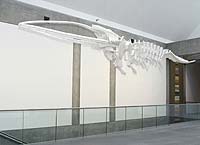|
|
Brian Jungen
Vienna, 2003
Plastic chairs
Purchased 2003 with the assistance
of the Joy Thomson Fund of the
National Gallery of Canada Foundation
Upon first viewing Vienna, we are struck by the immense scale and intricate beauty of what appears to be a suspended whale skeleton. On closer inspection it becomes apparent that this sculpture actually comprises hundreds of plastic patio chairs, cut up and reconfigured to allow their graceful lines and curves to come together as an elegant whale form. The ironic relationship between the material and its final form is not lost on the artist: the use of the ubiquitous plastic chair provides a social commentary on consumer society, yet at the same time the purchase of hundreds of these individual chairs was necessary in order to create the work. In an additional irony, the by-products of plastic manufacturing have done much to degrade the habitat of the large sea creatures these sculptures allude to.
Vienna is the third in a series of bold and dynamic whale sculptures Jungen began in 2000 with Shapeshifter. Acquired by the National Gallery of Canada in 2001, Shapeshifter reflects the shape-shifting abilities of supernatural creatures that animate traditional beliefs among many Aboriginal cultures. The work can also be read as the process of transforming an everyday item into monumental sculpture, which is also true of Vienna, whose title refers to the site of creation as well as to where the chairs that make up the whale skeleton were purchased or manufactured. Drawing attention to place serves to demystify the construction of the sculpture in a way that compels us to think about these items as commodities. Piecing together the individual chairscan be imagined as a series of transactions; broken apart, then rejoined, they are changed into something altogether new.
Vienna also forces us to reconsider our habits as consumers. The plastic skeleton is an environmental warning, the giants of the sea being the first in a string of casualties ultimately relating back to us. As well, Vienna acts as a reminder of how Aboriginal peoples and their material culture have been collected and exhibited. The artist draws a parallel between the display of animal skeletons in natural history museums and the exhibition of human remains in some anthropology museums.
Brian Jungen's Vienna springs from his analysis of contemporary consumer culture as well as from his ancestral link to the Dunne-za First Nation in northern British Columbia. From his perspective as a young, urban intellectual, Jungen skilfully positions his work within a paradoxical complex occupied by Aboriginal artists who produce beautiful objects that both challenge and participate in the worlds they critique.
|

